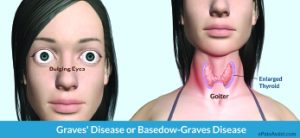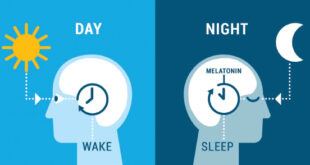By Lauren R. Rosecan, M.D., Ph.D., F.A.C.S.
 Graves disease is an autoimmune disorder that leads to over activity of the thyroid gland (hyperthyroidism). The gland produces hormones that regulate your body’s metabolism (the process by which the body transforms food into energy).
Graves disease is an autoimmune disorder that leads to over activity of the thyroid gland (hyperthyroidism). The gland produces hormones that regulate your body’s metabolism (the process by which the body transforms food into energy).
When Graves’ disease affects the eyes, the condition is known as thyroid associated ophthalmopathy (TAO) or thyroid eye disease. Graves’ disease usually appears before age 40.
Too much thyroid hormone along with circulating antibodies may cause the soft tissues and muscles that surround the eye to swell. Structures within the eye’s orbit — the bony space in which the eyeball sits — include muscles, blood vessels and nerves. When these structures swell within the enclosed space of the orbit, the eyes protrude or bulge. This may lead to problems moving the eyes, often resulting in double vision, one of the more common signs of thyroid ophthalmopathy.
Graves’ Disease Symptoms
Graves’ disease causes wide-ranging symptoms, some of which are related to the eye and others that are not.
Graves’ disease symptoms that are not related to the eye include
• Anxiety;
• Irritability;
• Difficulty sleeping;
• Fatigue;
• A rapid or irregular heartbeat;
• A tremor of hands or fingers;
• An increase in perspiration or warm, moist skin;
• Sensitivity to heat; and
• Weight loss, despite normal eating habits.
Thyroid disease and the eye
Graves’ disease can affect the eyes in multiple ways.
• Eyelid retraction. The combination of eyelid swelling and eye protrusion sometimes causes the eyelids to retract and reveal the sclera (the white part) of the eye.
• Eye protrusion. This occurs when the muscles around the eyes swell, which pushes the eye forward. People with this condition look as if their eyes are bulging or they are staring.
• Dry eye. Because of protrusion and eyelid retraction, the eyes are more exposed to the environment. This causes blurred vision, light sensitivity, dry eye, excessive tearing, irritation and inflammation.
• Double vision. Muscle swelling may cause double vision.
• Eye bags. Eyelid swelling can cause tissue around the eyes to bulge forward.
Who Is at Risk for Graves’ Disease?
Women are much more likely to develop Graves’ disease than men. Graves’ disease usually appears before the age of 40. Having a family history of Graves’ disease also increases your risk.
Other factors that can increase your risk for Graves’ disease include:
• Smoking, which also increases your risk for developing eye problems from the disease;
• Pregnancy or recent childbirth;
• Stress; and
• Having an autoimmune disorder, such as rheumatoid arthritis or type 1 diabetes.
Graves’ Disease Diagnosis
To determine if you have Graves’ disease or thyroid eye disease, your ophthalmologist will examine your eyes to see if they are irritated or protruding.
As part of a physical exam, your doctor will also check your pulse and blood pressure, and look to see if your thyroid gland is enlarged. Blood work may also be ordered to check the levels of thyroid hormones. Your Eye M.D. may also recommend a CT scan, which can help show swelling of certain eye muscles.
Graves’ Disease Treatment
If thyroid hormone levels are irregular, reducing the overproduction of thyroid hormone may be necessary. The eye problems associated with Graves’ disease may be treated by non-surgical and surgical methods.
Non-surgical treatment may include taking steroid medications by mouth to control swelling and inflammation of the eye muscles, wearing sunglasses frequently to relieve light sensitivity associated with thyroid eye disease, and applying lubricating ointment to relieve dry eye.
Surgical treatment for thyroid eye disease may include the following:
• Surgery of certain eye muscles to help treat double vision;
• Eyelid surgery to treat eyelid retraction and help protect the eye;
• A procedure called orbital decompression for certain advanced cases of thyroid eye disease. This procedure, aimed at treating eye protrusion, consists of creating targeted breaks in some of the orbital bones to allow the swelling to expand to other areas and not push the eyes outward.
Lauren R. Rosecan
M.D., Ph.D., F.A.C.S.
The Retina Institute of Florida with four offices
conveniently located in Palm Beach and Martin Counties.
Toll Free Phone Number: 1-800-445-8898
Or 561-832-4411
Check Also
WHAT IS MY CIRCADIAN RHYTHM AND WHY DOES IT MAKE ME FEEL SO “OFF”
By Renee Chillcott, LMHC Have you heard terms such as “biological clock” or “biorhythms”, or …
 South Florida Health and Wellness Magazine Health and Wellness Articles
South Florida Health and Wellness Magazine Health and Wellness Articles




